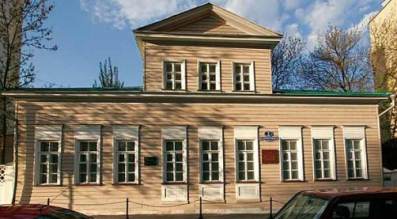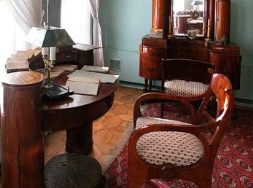

Ulitsa Malaya Molchanovka 1
Tel. (495) 691 5298
Subway: Arbatskaya
Open: 2pm- 6pm Wed, Fri
11am- 5pm Thu, Sat
/imagesCA8Y4DN8.jpg)


The Lermontov house-Museum (Дом- Музей М.Ф. Лермонтова) is a small building where the great Russian poet Mikhail Lermontov lived. The building itself was built in 1814 for the family of the Moscow merchant P. M. Chernov. The house has changed hands many times, but of course the most famous resident was Lermontov from August 1, 1828 until 1832, when it was rented by Lermontov's grandmother, Elizabeth Arsenieva. The house has miraculously survived to this day. Only at the end of the 20th century (February 19, 1981) it was turned into the house - Museum of M. Y. Lermontov. In 2014, in honor of the bicentennial of the birth of the Museum was restored.
Hidden behind the towers of the Novy Arbat quarter
is a modest wooden house where Mikhail Lermontov once lived. The
great romantic poet and writer lived here with his grandmother
Elizaveta Arseneva from 1829-32, when he was studying at Moscow
University. While here, he wrote an early draft of his narrative
poem "the Demon" (1839).
Lermontov was more interested in
writing poetry than studying, and left the University without
graduating. Then he joined the guard. For his political views, he
was exiled to the Caucasus for a year due to bitter criticism of the
authorities, expressed in his poem "The death of a poet" (1837).
This poem about the death of Pushkin was a turning point in
Lermontov's work. His most famous work, the novel Hero of our time,
was written in 1840. Lermontov died the following year, at the age
of only 26. Like Pushkin, he was killed in a duel.
There are
only five rooms in the M. Y. Lermontov Museum, but each one
testifies to Lermontov's intellectual gifts, as well as to his
private life. The mezzanine of the house was his favorite room. Here
he played guitar, piano and violin and even composed music. The
living room, which still contains much original furniture, was often
the scene of lively dancing, singing, and masquerades. Many of
Lermontov's manuscripts are displayed below, along with drawings and
watercolors made by Lermontov himself.
Mikhail Lermontov's life in Moscow is
connected with three addresses. He was born in the house of General
Karl Tolya at the Red Gate, and spent his childhood in a building on
Povarskaya street, which was rented by his grandmother Elizabeth
Arseniev. As a result of the reconstruction of the city center in
the XX century, both of these buildings were demolished. Lermontov
moved to the mansion on Malaya Molchanovka At the age of fifteen to
enter the Moscow noble boarding school. The poet lived there with
his grandmother from 1829 to 1832.
During the three years of
his life on Molchanovka, Lermontov wrote 17 poems, four dramas and
250 poems, including the tragedies " People and passions "and"
Spaniards", the drama" Strange man", the third edition of the poem"
Demon "and" Izmail Bey", the poem" Portrait","New year's madrigals
and epigrams". For the same period was "Sulkowski cycle" in the
works of Lermontov, dedicated to the love lived in a nearby
noblewoman Catherine Sushkov.
"In Moscow, I met and soon
became friends with Sashenka Vereshchagina. We lived next to each
other on Molchanovka And almost from the first meeting we became
inseparable: on the waters, at parties, at the theater, at evenings,
everywhere and always together. < ... > At Sashenka's I met her
cousin at this time, a clumsy, club-footed boy of sixteen or
seventeen, with red, but intelligent, expressive eyes, a turned-up
nose, and a sarcastic, mocking smile. He was a student at a
University boarding school, but his scholarly studies did not
prevent him from being our cavalier almost every evening at parties
and parties; everyone just called him Michel, and I did the same as
everyone else, not caring a bit about his last name. I called him my
official on special assignments, and gave him my hat, my umbrella,
and my gloves to save, but he often lost them, and I threatened to
dismiss him from the position entrusted to him.
From the memoirs
of Ekaterina Sushkova about Mikhail Lermontov»
In 1954, a
memorial plaque to Mikhail Lermontov was installed on the exterior
wall of the mansion. In 1977, the Moscow city Council transferred
the building to the state literary Museum. Irakli Andronikov played
an important role in the composition of the exposition and the
Museum's activities.thanks to his intervention, the building was
saved from demolition in 1938. Three years later, Andronikov
participated in the organization of the first exhibition dedicated
to Lermontov, but due to the beginning of the great Patriotic war,
the event did not take place. Collected exhibits from Leningrad,
Moscow, the Caucasus and Hochburg castle in Germany later formed the
basis of the Museum's collection.
In 1977, at the initiative
of Andronikov, a letter signed by the poet Pavel Antokolsky,
literary critics Emma Gerstein and Natalia Ivanova, artist Elena
Gogoleva, and actor Vladimir Pakhomov was sent to the editorial
office of Literaturnaya Gazeta. The letter spoke about the
significance of Lermontov's work for Soviet literature and the need
to open a Museum dedicated to the poet. The opening ceremony was
held in 1981.
In 1994, a monument to Lermontov by sculptor
Alexander Burganov and architect Mikhail Posokhin was erected next
to the building.